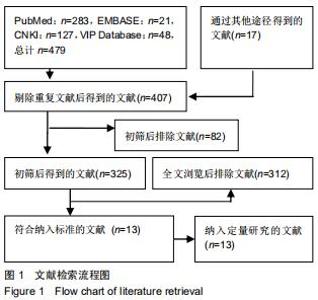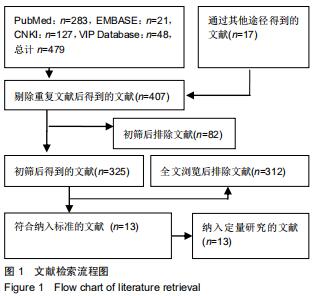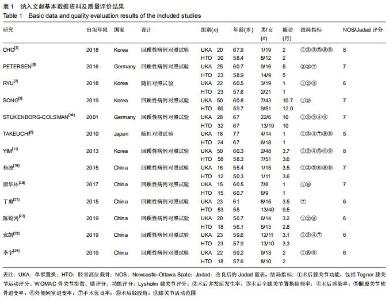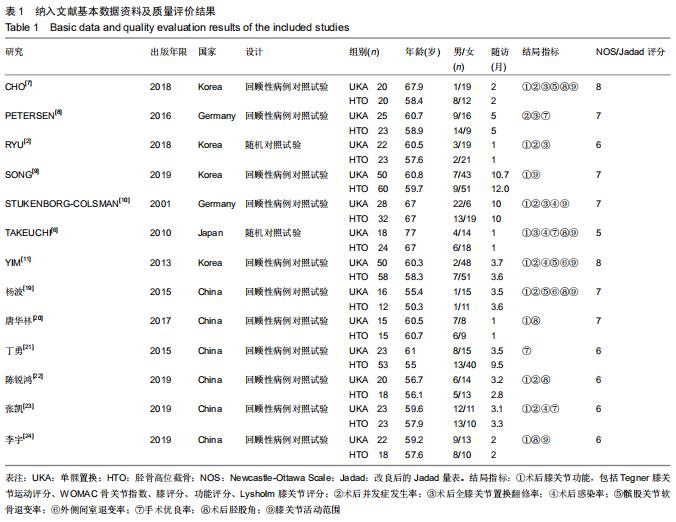Chinese Journal of Tissue Engineering Research ›› 2020, Vol. 24 ›› Issue (30): 4905-4913.doi: 10.3969/j.issn.2095-4344.2844
Previous Articles Next Articles
A meta-analysis of high tibial osteotomy and monocondylar replacement for treating medial interventricular osteoarthritis of the knee
Bai Hao1, Sun Haibiao2, Han Xiaoqiang2, Xue Jiangang1
- 1Shanxi Medical University, Taiyuan 030001, Shanxi Province, China; 2First Hospital, Shanxi Medical University, Taiyuan 030001, Shanxi Province, China
-
Received:2019-12-23Revised:2019-12-27Accepted:2020-03-04Online:2020-10-28Published:2020-09-22 -
Contact:Sun Haibiao, MD, Chief physician, First Hospital, Shanxi Medical University, Taiyuan 030001, Shanxi Province, China -
About author:Bai Hao, Master candidate, Physician, Shanxi Medical University, Taiyuan 030001, Shanxi Province, China -
Supported by:the Support Plan for Distinguished Professors of Young Scholars in Shanxi Province, No. [Jincai (2016)128-2]
CLC Number:
Cite this article
Bai Hao, Sun Haibiao, Han Xiaoqiang, Xue Jiangang. A meta-analysis of high tibial osteotomy and monocondylar replacement for treating medial interventricular osteoarthritis of the knee[J]. Chinese Journal of Tissue Engineering Research, 2020, 24(30): 4905-4913.
share this article
|
[1] LOESER RF. Aging and osteoarthritis: the role of chondrocyte senescence and aging changes in the cartilage matrix. Osteoarthritis Cartilage. 2009;17(8):971-979.
[2] RYU SM, PARK JW, NA HD, et al. High Tibial Osteotomy versus Unicompartmental Knee Arthroplasty for Medial Compartment Arthrosis with Kissing Lesions in Relatively Young Patients. Knee Surg Relat Res. 2018;30(1):17-22.
[3] HAN SB, KYUNG HS, SEO IW, et al. Better clinical outcomes after unicompartmental knee arthroplasty when comparing with high tibial osteotomy. Medicine (Baltimore). 2017;96(50):e9268.
[4] DETTONI F, BONASIA DE, CASTOLDI F, et al. High tibial osteotomy versus unicompartmental knee arthroplasty for medial compartment arthrosis of the knee: a review of the literature. Iowa Orthop J. 2010;30:131-140.
[5] KIM YJ, KIM BH, YOO SH, et al. Mid-term results of oxford medial unicompartmental knee arthroplasty in young asian patients less than 60 years of age: a minimum 5-year follow-up. Knee Surg Relat Res. 2017;29(2):122-128.
[6] TAKEUCHI R, UMEMOTO Y, ARATAKE M, et al. A midterm comparison of open wedge high tibial osteotomy vs unicompartmental knee arthroplasty for medial compartment osteoarthritis of the knee. J Orthop Surg Res. 2010;5(1):65.
[7] CHO WJ, KIM JM, KIM WK, et al. Mobile-bearing unicompartmental knee arthroplasty in old-aged patients demonstrates superior short-term clinical outcomes to open-wedge high tibial osteotomy in middle-aged patients with advanced isolated medial osteoarthritis. Int Orthop. 2018;42(10): 2357-2363.
[8] PETERSEN W, METZLAFF S. Open wedge high tibial osteotomy (HTO) versus mobile bearing unicondylar medial joint replacement: five years results. Arch Orthop Trauma Surg. 2016; 136(7):983-989.
[9] SONG SJ, BAE DK, KIM KI, et al. Long-term survival is similar between closed-wedge high tibial osteotomy and unicompartmental knee arthroplasty in patients with similar demographics. Knee Surg Sports Traumatol Arthrosc. 2019; 27(4):1310-1319.
[10] STUKENBORG-COLSMAN C, WIRTH CJ, LAZOVIC D, et al. High tibial osteotomy versus unicompartmental joint replacement in unicompartmental knee joint osteoarthritis: 7-10-year follow-up prospective randomised study. Knee. 2001;8(3):187-194.
[11] YIM JH, SONG EK, SEO HY, et al. Comparison of high tibial osteotomy and unicompartmental knee arthroplasty at a minimum follow-up of 3 years. J Arthroplasty. 2013;28(2):243-247.
[12] BODE G, VON HEYDEN J, PESTKA J, et al. Prospective 5-year survival rate data following open-wedge valgus high tibial osteotomy. Knee Surg Sports Traumatol Arthrosc. 2015;23(7): 1949-1955.
[13] BONASIA DE, DETTONI F, SITO G, et al. Medial opening wedge high tibial osteotomy for medial compartment overload/arthritis in the varus knee: prognostic factors. Am J Sports Med. 2014;42(3): 690-698.
[14] FU D, LI G, CHEN K, et al. Comparison of high tibial osteotomy and unicompartmental knee arthroplasty in the treatment of unicompartmental osteoarthritis: a meta-analysis. J Arthroplasty. 2013;28(5):759-765.
[15] HERRY Y, BATAILLER C, LORDING T, et al. Improved joint-line restitution in unicompartmental knee arthroplasty using a robotic- assisted surgical technique. Int Orthop. 2017;41(11): 2265-2271.
[16] SARAGAGLIA D, BEVAND A, REFAIE R, et al. Results with nine years mean follow up on one hundred and three KAPS(R) uni knee arthroplasties: eighty six medial and seventeen lateral. Int Orthop. 2018;42(5):1061-1066.
[17] RICHMOND JC. Surgery for osteoarthritis of the knee. Rheum Dis Clin North Am. 2013;39(1):203-211.
[18] SANTOSO MB, WU L. Unicompartmental knee arthroplasty, is it superior to high tibial osteotomy in treating unicompartmental osteoarthritis? A meta-analysis and systemic review. J Orthop Surg Res. 2017;12(1):50.
[19] 杨波,姜鑫.单髁置换术与胫骨高位截骨术治疗膝关节内侧间室骨关节炎的近期疗效比较[J].中国修复重建外科杂志,2015,29(5): 548-552.
[20] 唐华林,李玉军.单髁置换术与胫骨高位截骨术治疗膝骨性关节炎的效果对比分析[J].临床医药文献电子杂志,2017,4(77):15096-15097.
[21] 丁勇,李钊,胡运生,等.单髁置换术与胫骨高位截骨术治疗膝骨性关节炎疗效比较[J].生物骨科材料与临床研究,2015,12(2):75-77.
[22] 陈锐鸿,葛鸿庆,陈文治.单髁置换与胫骨高位截骨治疗膝关节内侧间室骨关节炎:1年随访比较[J].中国组织工程研究,2019,23(20): 3143-3147.
[23] 张凯,王晓鹏,戴志刚.胫骨高位截骨术与单髁置换术治疗膝内侧间室关节炎临床疗效对比[J].潍坊医学院学报, 2019,41(3):207-209.
[24] 李宇,王立志,郑秋,等.胫骨高位截骨与膝单髁置换治疗内侧间室骨关节炎的近期疗效比较[J].中国现代医学杂志, 2019,29(16):75-79.
[25] AMIN AK, PATTON JT, COOK RE, et al. Unicompartmental or total knee arthroplasty?: Results from a matched study. Clin Orthop Relat Res. 2006;451:101-106.
[26] KYUNG HS. High tibial osteotomy for medial knee osteoarthritis. Knee Surg Relat Res. 2016;28:253-254.
[27] PARKER DA, VISKONTAS DG. Osteotomy for the early varus arthritic knee. Sports Med Arthrosc. 2007;15:3-14.
[28] ENGH GA. Orthopaedic crossfire-can we justify unicondylar arthroplasty as a temporizing procedure? In the affirmative. J Arthroplasty. 2002;17:54-55.
[29] KO YB, GUJARATHI MR, OH KJ. Outcome of unicompartmental knee arthroplasty: a systematic review of comparative studies between fixed and mobile bearings focusing on complications. Knee Surg Relat Res. 2015;27:141-148.
[30] 宋伟,朱振国,徐进,等.单髁置换术与胫骨高位截骨术治疗膝关节骨性关节炎的荟萃分析[J].中国矫形外科杂志,2018,26(21): 1962-1968
[31] IVARSSON I, GILLQUIST J. Rehabilitation after high tibial osteotomy and unicompartmental arthroplasty. Clin Orthop Relat Res. 1991;266:139-144.
[32] ANDRIACCHI TP, GALANTE JO, FERMIER RW. The influence of total knee-replacement design on walking and stair-climbing. J Bone Joint Surg Am. 1982;64:1328-1335.
[33] WEINSTEIN JN, ANDRIACCHI TP, GALANTE J. Factors influencing walking and stair climbing following unicompartmental knee arthroplasty. J Arthroplasty. 986;1:109-115. [34] CARTIER P, SANOUILLER JL, GRELSAMER RP. Unicompartmental knee arthroplasty surgery. 10-year minimum follow-up period. J Arthroplasty. 1996;11:782-788. |
| [1] | Hu Kai, Qiao Xiaohong, Zhang Yonghong, Wang Dong, Qin Sihe. Treatment of displaced intra-articular calcaneal fractures with cannulated screws and plates: a meta-analysis of 15 randomized controlled trials [J]. Chinese Journal of Tissue Engineering Research, 2021, 25(9): 1465-1470. |
| [2] | Huang Dengcheng, Wang Zhike, Cao Xuewei. Comparison of the short-term efficacy of extracorporeal shock wave therapy for middle-aged and elderly knee osteoarthritis: a meta-analysis [J]. Chinese Journal of Tissue Engineering Research, 2021, 25(9): 1471-1476. |
| [3] | Li Dadi, Zhu Liang, Zheng Li, Zhao Fengchao. Correlation of total knee arthroplasty efficacy with satisfaction and personality characteristics [J]. Chinese Journal of Tissue Engineering Research, 2021, 25(9): 1346-1350. |
| [4] | Wei Wei, Li Jian, Huang Linhai, Lan Mindong, Lu Xianwei, Huang Shaodong. Factors affecting fall fear in the first movement of elderly patients after total knee or hip arthroplasty [J]. Chinese Journal of Tissue Engineering Research, 2021, 25(9): 1351-1355. |
| [5] | Wang Jinjun, Deng Zengfa, Liu Kang, He Zhiyong, Yu Xinping, Liang Jianji, Li Chen, Guo Zhouyang. Hemostatic effect and safety of intravenous drip of tranexamic acid combined with topical application of cocktail containing tranexamic acid in total knee arthroplasty [J]. Chinese Journal of Tissue Engineering Research, 2021, 25(9): 1356-1361. |
| [6] | Xiao Guoqing, Liu Xuanze, Yan Yuhao, Zhong Xihong. Influencing factors of knee flexion limitation after total knee arthroplasty with posterior stabilized prostheses [J]. Chinese Journal of Tissue Engineering Research, 2021, 25(9): 1362-1367. |
| [7] | Peng Zhihao, Feng Zongquan, Zou Yonggen, Niu Guoqing, Wu Feng. Relationship of lower limb force line and the progression of lateral compartment arthritis after unicompartmental knee arthroplasty with mobile bearing [J]. Chinese Journal of Tissue Engineering Research, 2021, 25(9): 1368-1374. |
| [8] | Huang Zexiao, Yang Mei, Lin Shiwei, He Heyu. Correlation between the level of serum n-3 polyunsaturated fatty acids and quadriceps weakness in the early stage after total knee arthroplasty [J]. Chinese Journal of Tissue Engineering Research, 2021, 25(9): 1375-1380. |
| [9] | Chen Junming, Yue Chen, He Peilin, Zhang Juntao, Sun Moyuan, Liu Youwen. Hip arthroplasty versus proximal femoral nail antirotation for intertrochanteric fractures in older adults: a meta-analysis [J]. Chinese Journal of Tissue Engineering Research, 2021, 25(9): 1452-1457. |
| [10] | Chen Jinping, Li Kui, Chen Qian, Guo Haoran, Zhang Yingbo, Wei Peng. Meta-analysis of the efficacy and safety of tranexamic acid in open spinal surgery [J]. Chinese Journal of Tissue Engineering Research, 2021, 25(9): 1458-1464. |
| [11] | Wang Yongsheng, Wu Yang, Li Yanchun. Effect of acute high-intensity exercise on appetite hormones in adults: a meta-analysis [J]. Chinese Journal of Tissue Engineering Research, 2021, 25(8): 1305-1312. |
| [12] | Liu Xiangxiang, Huang Yunmei, Chen Wenlie, Lin Ruhui, Lu Xiaodong, Li Zuanfang, Xu Yaye, Huang Meiya, Li Xihai. Ultrastructural changes of the white zone cells of the meniscus in a rat model of early osteoarthritis [J]. Chinese Journal of Tissue Engineering Research, 2021, 25(8): 1237-1242. |
| [13] | Kong Desheng, He Jingjing, Feng Baofeng, Guo Ruiyun, Asiamah Ernest Amponsah, Lü Fei, Zhang Shuhan, Zhang Xiaolin, Ma Jun, Cui Huixian. Efficacy of mesenchymal stem cells in the spinal cord injury of large animal models: a meta-analysis [J]. Chinese Journal of Tissue Engineering Research, 2021, 25(7): 1142-1148. |
| [14] | Zhong Hehe, Sun Pengpeng, Sang Peng, Wu Shuhong, Liu Yi. Evaluation of knee stability after simulated reconstruction of the core ligament of the posterolateral complex [J]. Chinese Journal of Tissue Engineering Research, 2021, 25(6): 821-825. |
| [15] | Zhao Zhongyi, Li Yongzhen, Chen Feng, Ji Aiyu. Comparison of total knee arthroplasty and unicompartmental knee arthroplasty in treatment of traumatic osteoarthritis [J]. Chinese Journal of Tissue Engineering Research, 2021, 25(6): 854-859. |
| Viewed | ||||||
|
Full text |
|
|||||
|
Abstract |
|
|||||





























